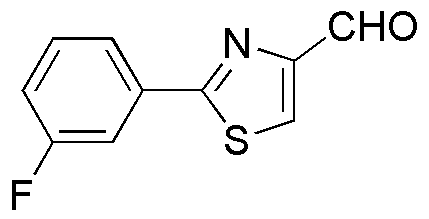2-(3-Fluorophenyl)thiazole-4-carbaldehyde is widely utilized in research focused on:
- Pharmaceutical Development: This compound serves as a valuable intermediate in the synthesis of various pharmaceuticals, particularly those targeting neurological disorders. Its unique structure allows for the modification of biological activity, making it a key player in drug discovery.
- Material Science: It is used in the development of advanced materials, such as organic semiconductors. Its electronic properties can enhance the performance of devices like solar cells and organic light-emitting diodes (OLEDs).
- Agricultural Chemistry: The compound has potential applications in agrochemicals, particularly in the formulation of pesticides and herbicides. Its efficacy in targeting specific pests can lead to more sustainable agricultural practices.
- Biochemical Research: Researchers utilize it in the study of enzyme inhibitors and receptor interactions, aiding in the understanding of various biological processes and disease mechanisms.
- Fluorescent Probes: Due to its fluorescent properties, it can be employed in the development of imaging agents for biological research, enabling scientists to visualize cellular processes in real-time.
General Information
Properties
Safety and Regulations
Applications
2-(3-Fluorophenyl)thiazole-4-carbaldehyde is widely utilized in research focused on:
- Pharmaceutical Development: This compound serves as a valuable intermediate in the synthesis of various pharmaceuticals, particularly those targeting neurological disorders. Its unique structure allows for the modification of biological activity, making it a key player in drug discovery.
- Material Science: It is used in the development of advanced materials, such as organic semiconductors. Its electronic properties can enhance the performance of devices like solar cells and organic light-emitting diodes (OLEDs).
- Agricultural Chemistry: The compound has potential applications in agrochemicals, particularly in the formulation of pesticides and herbicides. Its efficacy in targeting specific pests can lead to more sustainable agricultural practices.
- Biochemical Research: Researchers utilize it in the study of enzyme inhibitors and receptor interactions, aiding in the understanding of various biological processes and disease mechanisms.
- Fluorescent Probes: Due to its fluorescent properties, it can be employed in the development of imaging agents for biological research, enabling scientists to visualize cellular processes in real-time.
Documents
Safety Data Sheets (SDS)
The SDS provides comprehensive safety information on handling, storage, and disposal of the product.
Product Specification (PS)
The PS provides a comprehensive breakdown of the product’s properties, including chemical composition, physical state, purity, and storage requirements. It also details acceptable quality ranges and the product's intended applications.
Certificates of Analysis (COA)
Search for Certificates of Analysis (COA) by entering the products Lot Number. Lot and Batch Numbers can be found on a product’s label following the words ‘Lot’ or ‘Batch’.
*Catalog Number
*Lot Number
Certificates Of Origin (COO)
This COO confirms the country where the product was manufactured, and also details the materials and components used in it and whether it is derived from natural, synthetic, or other specific sources. This certificate may be required for customs, trade, and regulatory compliance.
*Catalog Number
*Lot Number
Safety Data Sheets (SDS)
The SDS provides comprehensive safety information on handling, storage, and disposal of the product.
DownloadProduct Specification (PS)
The PS provides a comprehensive breakdown of the product’s properties, including chemical composition, physical state, purity, and storage requirements. It also details acceptable quality ranges and the product's intended applications.
DownloadCertificates of Analysis (COA)
Search for Certificates of Analysis (COA) by entering the products Lot Number. Lot and Batch Numbers can be found on a product’s label following the words ‘Lot’ or ‘Batch’.
*Catalog Number
*Lot Number
Certificates Of Origin (COO)
This COO confirms the country where the product was manufactured, and also details the materials and components used in it and whether it is derived from natural, synthetic, or other specific sources. This certificate may be required for customs, trade, and regulatory compliance.


